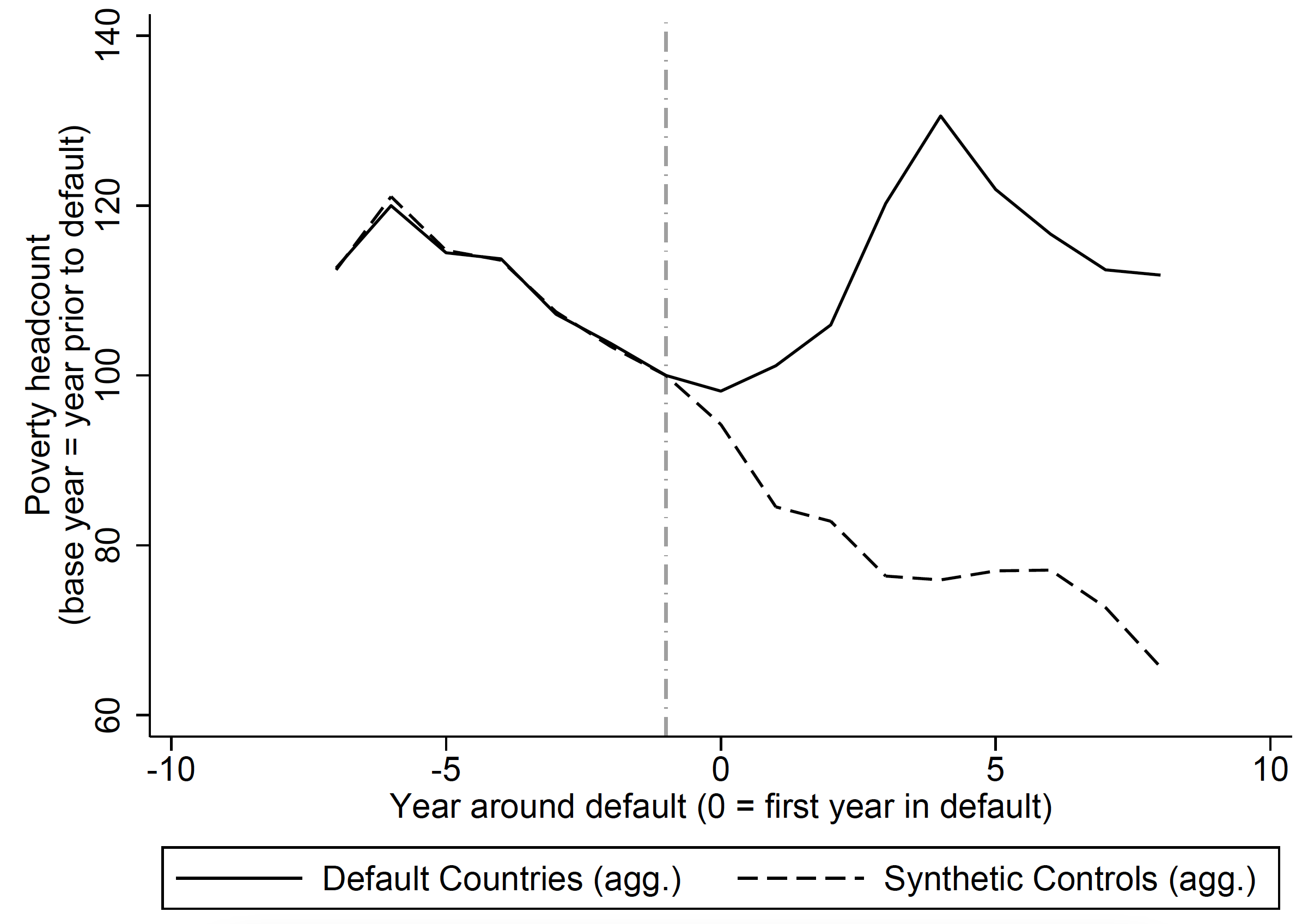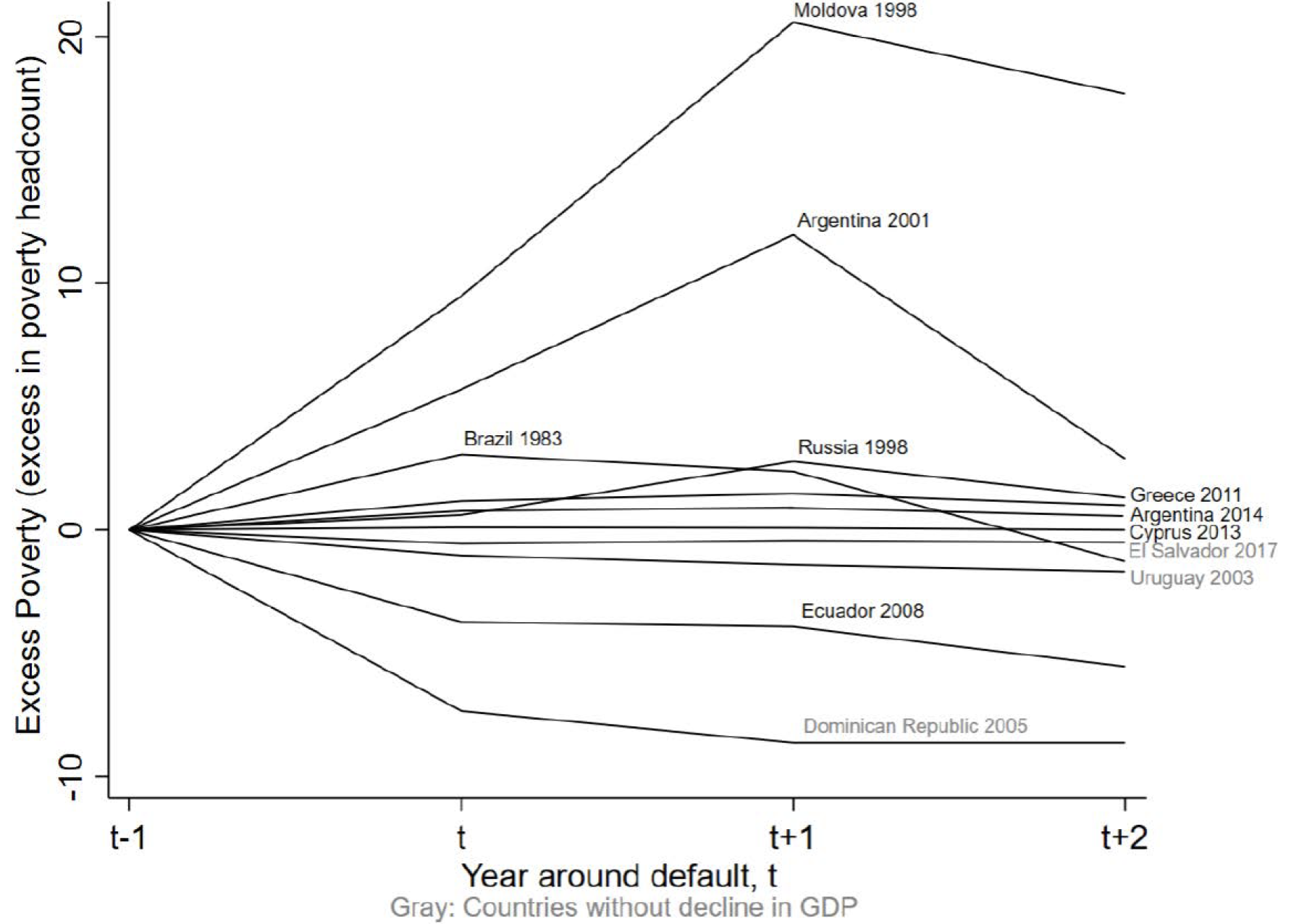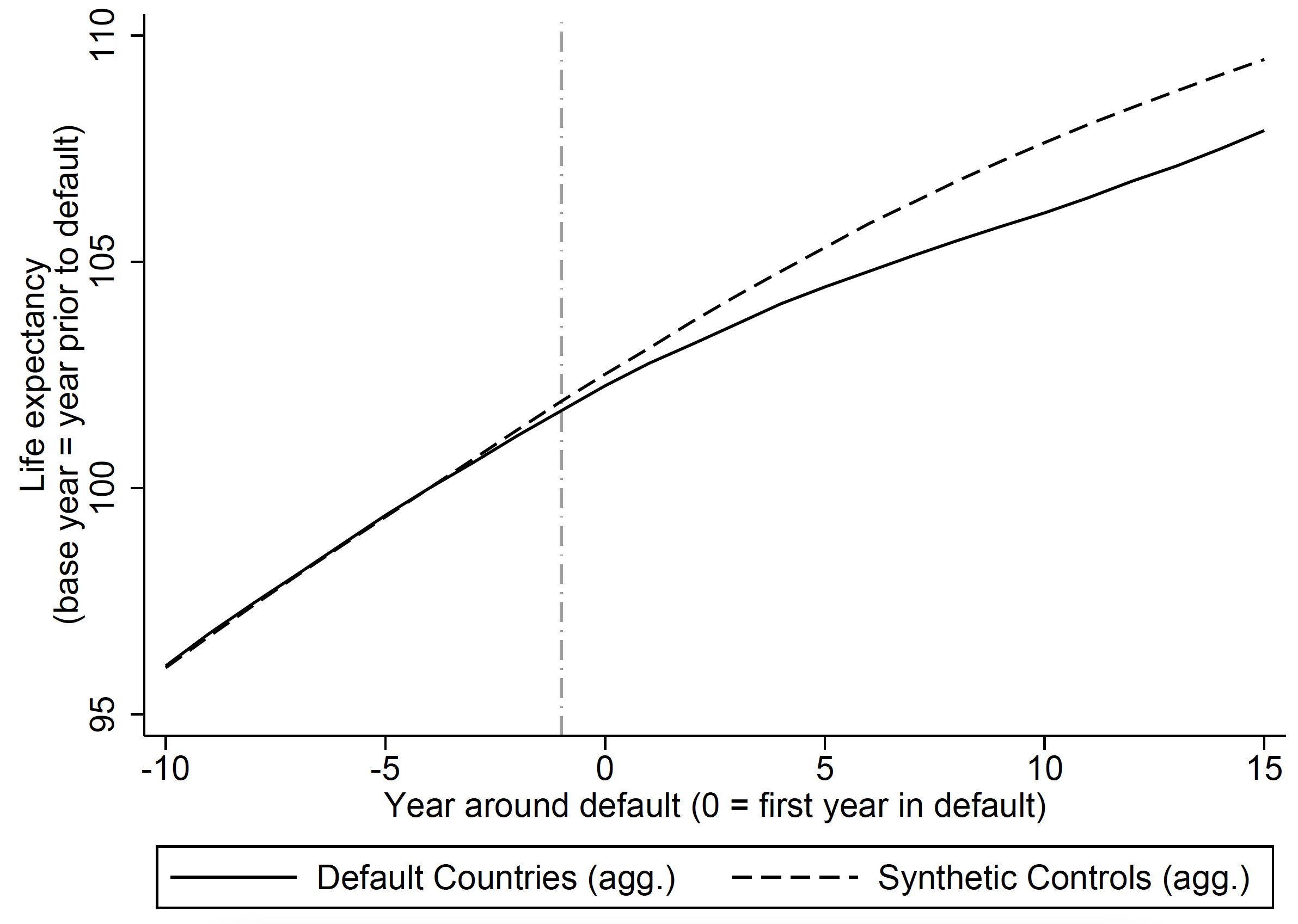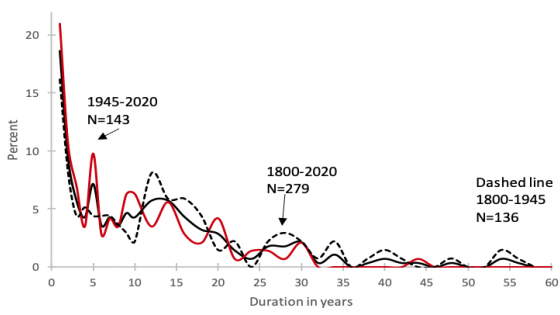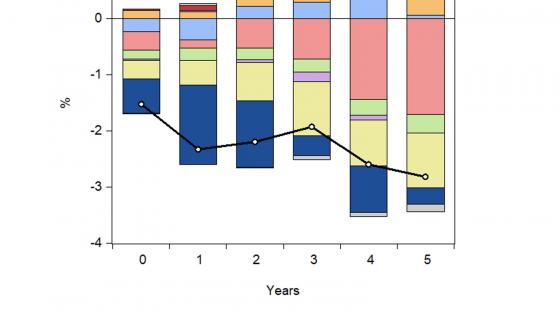In the shadow of the pandemic, significant threats to sovereign debt sustainability were already evident in many emerging market and developing economies, as discussed in the World Bank’s most recent World Development Report (World Bank 2022: Chapter 5). Such concerns have only escalated since, after the Russian invasion of Ukraine and the forceful pivot toward policy tightening by many central banks. While the aggregate economic consequences of debt distress have been widely examined in the literature, less attention has been focused on broader societal dislocations. Our recent paper (Farah-Yacoub et al. 2022a) traces out the paths on a variety of measures of poverty and performance in the aftermath of 131 defaults since 1900. Our emphasis is on counterfactual exercises that compare the default experience with the path that could have been taken from the same initial conditions but without debt distress using the synthetic controls method.
The synthetic controls methodology
To identify the effect of a sovereign default on socioeconomic outcomes, one would have to know what would have happened without the default or at least approximate it. To this end, we apply a synthetic control method (Abadie et al. 2010).
It systematically constructs a weighted combination of observations (that is, other countries’ outcomes) that minimises the difference of the chosen control with respect to the pre-treatment trend in the variable of interest, as well as a set of relevant predictors, prior to treatment. In other words, the methodology allows us to simulate the path that outcome variables would likely have followed absent a default.
An important advantage of this methodology as applied in this context is that it does not restrict the time variation in the effect of an intervention, allowing us to estimate how the effect of default changes over the years after default. This stands in contrast with the prior literature using panel data models, where typically the effects of defaults were restricted to be constant over time post default.
Real per capita income and poverty in the face of default
Our results strongly suggest that a sovereign default markedly reduces living standards in the debtor country and increases poverty levels. The year after default, the growth of GDP per capita lags that of their controls by 3.6%, poverty spikes 30% over pre-crisis levels (Figures 1 and 2), and indicators of welfare such as access to nutrition, infant mortality, and life expectancy, which correlate with real per capita income, suffer. Moreover, all these effects worsen over time.
Figure 1 Effect of default on real GDP per capita
Note: Based on 131 defaults since 1900, where data exists and that are not filtered because of coinciding armed conflict. Real GDP p.c. indexed to 100 at t-1.
Source: Maddison GDP Data, Authors’ Calculations.
Figure 2 Effect of default on poverty headcounts
Note: poverty head count defined as individuals per 1000 inhabitants that earn less than USD 1.9 PPP. Based on 20 default episodes since 1988, where data exists and that are not filtered because of coinciding armed conflict.
Source: PIP; Authors’ Calculations.
Prior studies have found defaults and debt crises usher in significant and lasting economic contraction. Others, though, find the impact of sovereign default on output to be less marked, with growth being quick to return (Borenzstein and Panizza 2010, Esteves et al. 2021). We reconcile the difference by considering the longer-term effects on cumulative economic performance. A decade after the event, the gap in per capita GDP between a sovereign defaulter and the counterfactual cumulates to 17%. These results highlight that while growth may rebound in somewhat short order, the impact of default on levels endures well past what traditional methodologies have been able to identify.
Macroeconomic growth has in turn been linked to poverty reduction (Dollar et al. 2013), so it is intuitive that a recession would also increase poverty levels. However, the more appropriate metric to consider is the counterfactual path had there been no default, not the raw response. Not only does the average defaulter see poverty headcounts jump 30% over pre-default levels a year after default, our synthetic controls suggest that the level would have been 70% lower in the absence of a default (Figure 2).
Note that this dismal performance considers a national default in isolation. In the 1980s, as in the 1930s, multiple countries defaulted at the same time. At the peak in 1989, roughly one-third of existing sovereigns were in default (Farah-Yacoub et al. 2022b). That same year, poverty at the global level spiked 3 percentage points from 33.9% to 36.9 percent
– i.e. there were 186 million new poor globally. Synchronous default waves default spells have tended to be longer, with Graf von Luckner et al. (2021) finding that the average spell duration in the 1980s was 11 years. We find that the effects on growth and poverty are accentuated for longer default spells, so waves of defaults could be even worse.
Poverty and income distribution
Is the effect on poverty just a function of average incomes plummeting and creating ‘new poor’? Our aggregate result may reflect the construction of poverty headcounts by the PIP
(formerly PovCalNet), binding it mechanically to adverse national income dynamics uniformly shrinking the aggregate pie. Yet, if we constrain ourselves to using the handful of cases for which compatible continuous annual surveys exist during and around the default year, the results provide evidence of significant regressive effects. In select cases, there is considerable excess poverty. The amount of new poor over what would be expected for a given reduction in average incomes (excess poverty) rises into the double-digits. For example, after its 1998 default, Moldova’s poverty headcount peaked with an additional 20 percentage points over what would be implied if the growth collapse had been absorbed proportionally by individuals across the entire income distribution.
The results, though skewed regressive, are heterogeneous (Figure 3). Four cases – Moldova, Argentina (2001), Brazil, and Russia – present sizeable increases in poverty over what would be implied by the growth shock. Greece, Cyprus, Argentina (2014), El Salvador, and Uruguay remain close to zero for excess poverty, which means changes in the poverty headcount are driven mainly by the average reduction in income. And, lastly, Ecuador and the Dominican Republic present negative excess poverty figures. These two cases also continued to grow consistently during the default period. Note, however, both were of pre-emptive restructuring rather than ‘hard’ defaults (Asonuma and Trebesch 2016), which can free up resources for alternative budgetary measures, importantly including social spending. In the Dominican Republic’s case (as well as the other cases marked in grey), the default was not accompanied by recession, and inflation seems to have been precipitously high in the year prior to default but controlled during the default. Ecuador’s default was accompanied by a relatively benign one-year decline in GDP of around 2%. Uruguay for its part suffered contagion from Argentina and responded swiftly with macroeconomic measures and swift restructuring.
Figure 3 Excess poverty in select cases
Note: Includes the 11 default episodes since 1980, where annual survey-based income distributions are available.
Source: PIP, authors’ calculations.
Taking a more strictly distributional view and considering the income of households at different levels of the income curve during output collapses associated with a default (eight out of the above cases) points to a regressive relationship. The cumulative drop in the level of national income going to the bottom 10% of the distribution is 9% when measured from peak to trough during a t-1 to t+2 window around default. For the bottom half of the distribution (including the bottom ten percent), incomes drop roughly 6.4%. On the flip side, households in the top 10% gained roughly 8.7% – all despite an average cumulative per capita GDP collapse of roughly 8.5%. These distributional results are a worthy consideration of political economists.
Social indicators beyond poverty
As has been pointed out before, using GDP per capita as a measure of welfare has limitations, and poverty headcounts are not without caveats. We also explore the dynamics of variables proxying common components of multi-dimensional poverty indicators and find that there are significant declines in other aspects that affect the general standard of living.
Calorie supply, a proxy for access to nutrition, begins to lag compared to counterfactuals immediately upon default and the gap grows to about 4% over the course of ten years. Energy supply is reduced, with the gap against the counterfactual growing to 10% by year three (though our study fails to find the statistical difference to be significant here and this specific result should be read as merely descriptive). Health and life expectancy outcomes paint the grimmest picture. While the gap in infant mortality begins to make its presence known early on, by year ten it is 13% higher for defaulters (figure 4). Should the child survive, she is then expected lead a life about 1.5% shorter than children born in non-defaulting counterfactuals – roughly 1.2 years (Figure 5).
Figure 4 Infant mortality
Note: Based on 81 default episodes since 1960, where data exists and that are not filtered because of coinciding armed conflict.
Source: United Nations, Authors’ Calculations.
Figure 5 Life expectancy
Note: Based on 77 default episodes since 1960, where data exists and that are not filtered because of coinciding armed conflict.
Source: FAO. Authors’ Calculations.
The last word
In all, sovereign defaults can usher in or contribute to what could be considered a humanitarian crisis – not just a financial one. The human costs of the default are in turn likely to make the country more vulnerable to political and social unrest and future financial crises, as lagging access to nutrition brings further declines in health outcomes. Worsening health outcomes and reduced energy supply hamper productivity. Hampered productivity leads to lagging incomes and the development of further macroeconomic vulnerabilities. These findings point to the potential existence of vicious cycles and adverse longer-term consequences that may profoundly impact the path of development.
References
Abadie, A, A Diamond and J Hainmueller (2010) “Synthetic Control Methods for Comparative Case Studies: Estimating the Effect of California’s Tobacco Control Program,” Journal of the American Statistical Association 105(490): 493-505.
Asonuma, T and C Trebesch (2016) “Sovereign Debt Restructurings: Preemptive or Post-Default,” Journal of the European Economic Association 14(1): 175–214.
Borensztein, E and U Panizza (2010), “The costs of sovereign default: Theory and reality,” VoxEU.org, May 6.
Esteves, R S, Kenny and J Lennard (2021) “The aftermath of sovereign debt crises”, VoxEU.org, July 20.
Farah Yacoub, J P, C Graf von Luckner, R Ramalho and C Reinhart (2022a), “The Social Costs of Sovereign Default.”
Farah Yacoub, J, C Graf von Luckner and C Reinhart (2022b), “Eternal external debt crises: A long view”, forthcoming.
Graf von Luckner, C, J Meyer, C Reinhart and C Trebesch (2021), “External sovereign debt restructurings: Delay and Replay,” VoxEU.org, March 30.
Dollar, D, T Kleineberg and A Kraay (2013), “Growth still is good for the poor”, VoxEU.org, Nov 19.
World Bank (2022), Finance for an Equitable Recovery, World Development Report 2022.






